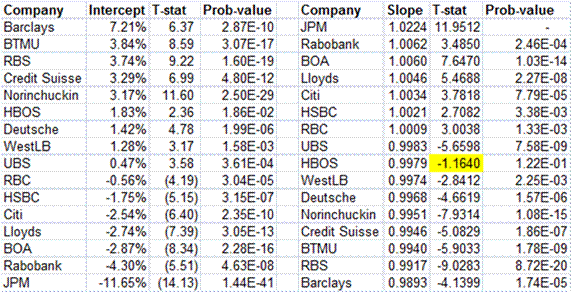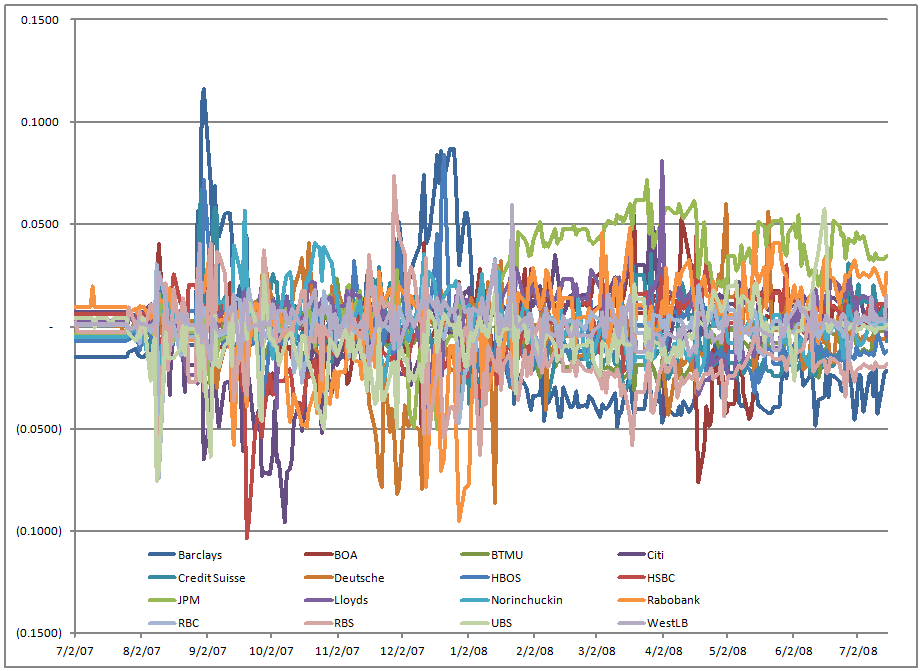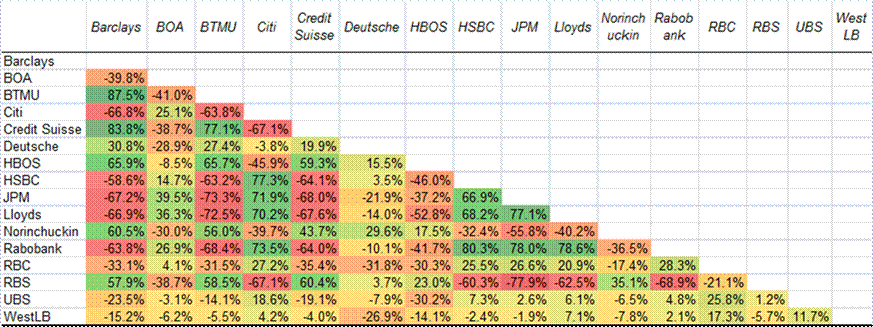New Highs, New Lows, Yield Greed
When I read this post by Ivan Hoff, I decided to look at the new high and new lows lists, which I never do now, but used to do regularly back in the days when I read a paper Wall Street Journal every day.? Now our philosophies for doing so differ.? He is looking for buy high, sell higher, and I am looking for misunderstood companies that are first safe, then cheap.
So after the close, I copied the new highs and new lows for the NYSE, NASDAQ, and Amex as a group.? There were 203 highs and 89 lows.
But then I noticed something funny: a large number (53) of the new highs came from preferred stock, hybrid debt, and bonds — yieldy stuff.? With the lows, there was some weird stuff, but 7 companies had rights and warrants, hitting new lows, and one new muni bond fund, NKGD, which was just noise.
Then I looked at the industries that they were in, mostly to separate out the ETPs and CEFs from everything else.? Here are the tables:
New Highs
| Values | ||
| Row Labels | Sum of mktcap | Count of ticker |
| 0715 – Insurance (Property & Casualty) |
205,242 |
2 |
| 0524 – Tobacco |
97,162 |
2 |
| 0803 – Biotechnology & Drugs |
62,010 |
8 |
| 0521 – Personal & Household Products |
40,837 |
2 |
| 0963 – Retail (Specialty Non-Apparel) |
38,396 |
1 |
| 1203 – Electric Utilities |
20,944 |
7 |
| 0515 – Food Processing |
17,571 |
1 |
| 0721 – Misc. Financial Services |
15,158 |
57 |
| 0115 – Forestry & Wood Products |
11,980 |
1 |
| 0727 – Regional Banks |
6,434 |
22 |
| 0806 – Healthcare Facilities |
5,358 |
3 |
| 1209 – Water Utilities |
4,356 |
2 |
| 1106 – Airline |
3,595 |
2 |
| 1206 – Natural Gas Utilities |
3,363 |
2 |
| 0812 – Medical Equipment & Supplies |
3,209 |
4 |
| 0957 – Retail (Grocery) |
2,472 |
3 |
| 0951 – Retail (Department & Discount) |
2,356 |
1 |
| 1018 – Computer Services |
2,039 |
1 |
| 1024 – Electronic Instruments & Controls |
1,790 |
1 |
| 0612 – Oil Well Services & Equipment |
1,335 |
1 |
| 0730 – S&Ls/Savings Banks |
1,290 |
9 |
| 0915 – Communications Services |
1,007 |
2 |
| 1036 – Software & Programming |
832 |
2 |
| 0718 – Investment Services |
548 |
2 |
| 0209 – Construction – Supplies and Fixtures |
494 |
2 |
| 0712 – Insurance (Miscellaneous) |
347 |
1 |
| 0942 – Restaurants |
333 |
1 |
| 0703 – Consumer Financial Services |
322 |
2 |
| 1033 – Semiconductors |
316 |
1 |
| 0421 – Furniture & Fixtures |
120 |
1 |
| 0909 – Business Services |
33 |
1 |
| 1003 – Communications Equipment |
31 |
1 |
| 0133 – Paper & Paper Products |
17 |
1 |
| 0912 – Casinos & Gaming |
0 |
1 |
| Grand Total |
551,295 |
150 |
| Exclude Misc Fin Svcs |
536,137 |
93 |
New Lows
| Values | ||
| Row Labels | Sum of mktcap | Count of ticker |
| 0118 – Gold & Silver |
41,488 |
9 |
| 1036 – Software & Programming |
16,268 |
7 |
| 1003 – Communications Equipment |
14,856 |
7 |
| 0515 – Food Processing |
12,732 |
2 |
| 1033 – Semiconductors |
10,351 |
2 |
| 1109 – Misc. Transportation |
8,131 |
1 |
| 0206 – Construction & Agricultural Machinery |
5,849 |
1 |
| 0948 – Retail (Catalog & Mail Order) |
5,451 |
1 |
| 0951 – Retail (Department & Discount) |
4,837 |
1 |
| 0603 – Coal |
4,479 |
2 |
| 0424 – Jewelry & Silverware |
4,243 |
1 |
| 0103 – Chemical Manufacturing |
3,933 |
3 |
| 0203 – Aerospace and Defense |
2,995 |
1 |
| 1018 – Computer Services |
2,851 |
3 |
| 0218 – Misc. Capital Goods |
2,300 |
2 |
| 0924 – Personal Services |
2,292 |
1 |
| 0927 – Printing & Publishing |
2,043 |
1 |
| 0124 – Metal Mining |
2,024 |
2 |
| 0721 – Misc. Financial Services |
1,903 |
2 |
| 0215 – Construction Services |
1,802 |
1 |
| 0939 – Rental & Leasing |
1,760 |
1 |
| 0915 – Communications Services |
1,616 |
1 |
| 0418 – Footwear |
1,439 |
1 |
| 1024 – Electronic Instruments & Controls |
1,384 |
2 |
| 0909 – Business Services |
1,223 |
1 |
| 0812 – Medical Equipment & Supplies |
1,077 |
5 |
| 0612 – Oil Well Services & Equipment |
1,075 |
1 |
| 0918 – Hotels & Motels |
937 |
1 |
| 0969 – Schools |
836 |
1 |
| 0609 – Oil & Gas Operations |
820 |
1 |
| 0933 – Real Estate Operations |
731 |
1 |
| 0415 – Auto & Truck Parts |
703 |
2 |
| 0127 – Misc. Fabricated Products |
693 |
2 |
| 1021 – Computer Storage Devices |
512 |
2 |
| 0966 – Retail (Technology) |
418 |
1 |
| 0703 – Consumer Financial Services |
195 |
1 |
| 0806 – Healthcare Facilities |
64 |
1 |
| 0727 – Regional Banks |
61 |
1 |
| 0803 – Biotechnology & Drugs |
54 |
2 |
| 0930 – Printing Services |
6 |
1 |
| 0942 – Restaurants |
5 |
1 |
| 0421 – Furniture & Fixtures |
4 |
1 |
| Grand Total |
166,437 |
81 |
| Exclude Misc Fin Svcs |
164,534 |
79 |
By the time you are done separating out the passive vehicles, because one is miscategorized in the new highs, you have for regular stocks 92 highs versus 79 lows.? The market cap spread favors the highs because of Berkshire Hathaway, Altria, Amgen, Target, Kimberly Clark, Reynolds American, and H.J. Heinz.? The only large company among the lows was Barrick Gold.
I should add that all of the ETPs and CEFs making new highs were all fixed income funds.? ALL!
Then I looked at the yields of the common stocks that were making new highs and new lows.? For new highs, 35 out of 92 (38%) have yields over 2%.? For new lows, 10 out of 79 (13%) have yields over 2%.
This is a market that is driven by yield and safety/non-cyclicality.? The new highs are predominantly in stable industries, and the new lows in cyclical industries.
I’ve said it before, but I’ll say it again, yield is not real.? It is a residual of a larger economic process.? If you own a bond, preferred stock, or common stock that pays dividends, your future well-being relies on the economic success of that company.? With stocks, that connection is direct, with bonds it means avoiding default.? Other securities face similar limits.? Yields cease to exist when companies fail; chasing yield as a main strategy will fail, because fund shareholders will give up during the hard times when capital gets marked down, and sell.
Though the portfolio that I manage for clients has an above average dividend yield, I do not look for dividend yields; I look for solid companies, and the dividend yields find me.? (Buybacks too.)? I do not reach for yield.? There are many investors that are reaching for yield in this environment, and I think they will eventually get burned.
So be wary over yield.? It may not pop for a year or two; it might pop tomorrow.? I identify risks, and risks typically don’t come with dates.? Just be wary.? When everyone is scrambling for yield, it is probably best to not aim for a yieldy portfolio.
PS — note all the banks and S&Ls on the new highs list, and they are almost all small firms.
Full Disclosure: long AMGN






